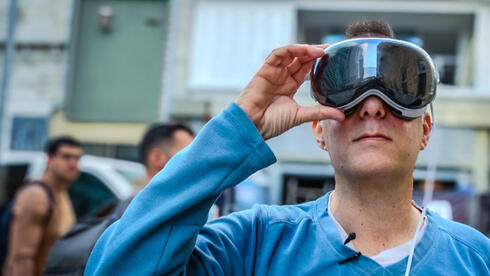
Gadget review
Apple Vision Pro test-drive: Pricey innovation very few people need
"You can work with the headset - browse, read documents, watch content, and more, but it still feels mostly like a toy for the rich or a tool for developers," writes Itai Smuskowitz
Perhaps in the last few days you have come across videos of people walking the streets of New York (or another city) with Apple's new Vision Pro headset, appearing disconnected from their surroundings. We managed to get a pair for a short test and initial review, and rest assured that is actually not a problem, except for the stares they attract from onlookers.
Let's start from the beginning: when you put on the glasses for the first time, the device's system detects your eyes and automatically adjusts the display according to them. You have to press a button on the frame of the glasses until the ideal point is found for the person who is using the device. After that, you have to get used to how to use the device, and for that, there is a short setup process - at the beginning, one point appears on the screen, and you have to look at it and make a pinching motion with your fingers to select it. This principle holds true all the way - look at the menu, link, or icon you want to open and pinch with your fingers.
Later on, there are 2-3 more screens with more points, to ensure that the system is calibrated and that you understand how it works. Then you go to the main screen. This short process causes a small shock when you realize that the system recognizes the eye movements and follows them. It feels like a step before mind-reading.
The headset looks cumbersome in the city because of the connection to an external battery, it does not feel heavy or bulky. I used the headset while standing and walking with the battery in my pants pocket, and when sitting or lying down, you have to find a place for it where it won't get in the way. The headset fits on the head easily, and I didn't feel that it was pressing or uncomfortable, although after a little less than an hour of use, marks appeared on the nose. By the way, at the end of the tour with the glasses, 57% remained in the battery, which means it should be enough for two to three hours.
After the first setup of the device (and the shock), the main screen hovers in front of you but does not hide reality - the background is transparent, and the display does not hide the surroundings. You can change that using the crown, a dial like the one on Apple watches, which allows you to hide the background completely, like a background image on a computer. Only here it can surround you from all directions, or stay behind the main screen while the rest of the surroundings are still visible on the sides.
Now you can start browsing. Whatever app you focus on stands out a bit from the rest and to select it you have to pinch with your fingers. It may sound complicated but you get used to it quickly, and it just works, simply. The problem is that the display of the applications is normal, and in Safari, for example, the buttons are close to each other. The system knows where you're looking and is usually accurate, but it's enough for the eye to wander a little to the side, and you'll find that you've chosen a different menu than the one you intended.
A small bar appears under each open application, with the help of which you can grab the entire window and move it to another place. Little by little, you can build a work environment for yourself - open the Safari browser, Apple TV, Apple Music, the photos application, and more, and drag each window to another place in the space in front of you, including the sides. Yes, as with other Apple devices, the idea is, of course, that you use the company's apps.
The windows you opened stay in place as long as you don't move. When you start walking, you will pass "through" the open screen, and it will stay behind you (if you turn around, you can see it from the other side, in a mirror image). Therefore, those who walk with the glasses on the street are not really cut off from the environment because the window does not continue to float in front of them. In fact, when I returned from a short walk, I found a window that continued to float near a street corner on the road I had passed earlier. There are also built-in speakers in the glasses, which are mainly intended for you, but those who are close to you will also hear at least some of the sounds.
So each window can have its place, and you can also choose to enlarge the view; not all of them have to be equal. If you want to watch a movie on YouTube or Apple TV, you can focus for a moment on the corner of the screen until a small mark appears there. When you drag it, the screen will enlarge. If you move your hand in the other direction, the screen will shrink back. When displaying images, you can also zoom, again using hand movements.
A look and a pinch don't solve everything: in any search window, whether it's in Safari or Apple Music, you can open a keyboard that will float in front of you in the air, just below the glasses, and use it. You also have to get used to this - it seems for a moment as if the typing is done in the air, but you have to play the game and actually press the keys, even if they don't exist at all in reality. A bit confusing. You can also focus your eyes on each individual letter and pinch it to compose text, and of course, there is also a voice search (and Siri). All of this currently only works in English; you can't change the language on the keyboard either, to remind you that the glasses are currently only available in the United States.
To see pictures and surf the Internet or watch movies on a big screen, you don't need a headset that costs $3,500, which is why Apple integrates additional content into the device that you won't be able to experience on other devices. You can watch the 3D photos and videos you took with the iPhone (the format Apple calls Spatial), and then feel as if you are entering the image and returning to the moment it was taken. Apple TV has content that is especially suitable for the new headset, to take advantage of the additional capabilities, for example, watching movies from someone else's point of view like walking on a tightrope. Imagine how it would feel to watch an Inter Miami soccer game from the perspective of a spectator in the stadium and maybe even through Leo Messi's eyes, for example - Apple already has the rights to the broadcasts; now we just need suitable filming equipment.
There is also a game that highlights the new abilities, a Super Fruit Ninja game where you have to cut the fruits that float in front of you. To activate it, you first need to find a place with enough free physical space - in a relatively crowded room, it was difficult to find such a point where all the details of the game would appear.
On the one hand, the use of the device is quite intuitive, and after a few moments, you get used to the idea of looking and pinching. When I walked around with the glasses, I didn't feel cut off from the world; I saw the whole environment without problems. But when I took them off at the end of use, there was a somewhat blurring moment of returning to reality.
The important and obvious questions are: Who needs it? Who is it suitable for? And whether the price is justified. The answer: not clear. The initial filter is the price, of course - if you can afford to buy such a product for $3,500 for fun then good for you.
After we passed this hurdle - what is it good for? Broadly speaking, it feels like an iPhone or iPad that is constantly in front of you, with a familiar operating system, apps that behave the same, and a virtual screen that can house a workspace with several open windows floating around you. It seems that the natural and obvious use will be watching movies, thanks to the ability to open a large screen in good quality anywhere, with or without adapted content.
Beyond that, you’ll have to wait for additional content and apps that will be adapted to the new capabilities so that the headset is not just an iOS-like screen that floats in front of your eyes. It is worth remembering that the first iPhone was launched without an app store (Steve Jobs didn't want to hear about external apps being installed on the company's device) and without connection to 3rd generation cellular networks. Despite this, it heralded a huge revolution that was realized in the models that came after it. And maybe in the next models of the Vision Pro, the price will be more accessible and will solve the main barrier, and developers will find innovative uses that will also answer the questions of who needs it and what is it good for. Yes, you can work with the headset - browse, read documents, watch content, and more, but it still feels mostly like a toy for the rich or a tool for developers.
















